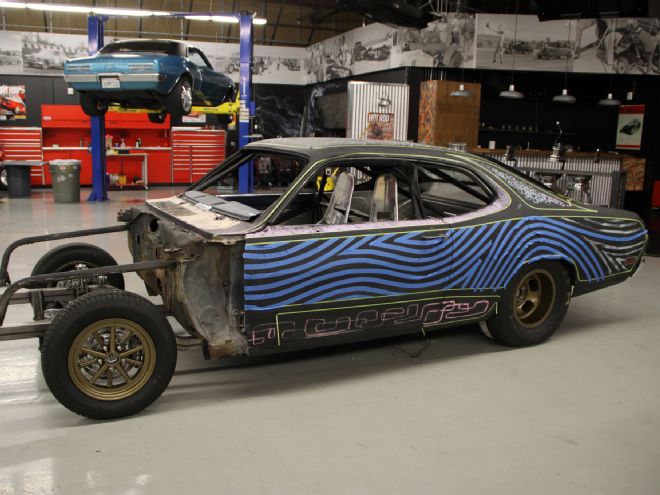
"Before getting started, the vehicle must be 100-percent complete." That is the first line in the instructions for measuring the baseline spring rate on a Chris Alston drag race A-arm suspension and frame clip. Not that we read directions, but this one was written in big letters so we thought we'd mention it. What the guys at Chassisworks meant was the car must have everything installed and be running, full of gas, and feature a driver behind the wheel before you start adjusting the suspension.
To get this far, we welded the Chassisworks 0.083-inch 2x3 front frame kit onto our swap-meet Demon to both get the front end to work with the previously back-halved rear and to add some needed adjustability to the suspension. In the process, we gained total control over the shock rate and spring preload, the ability to place the engine almost anywhere in the chassis, and dropped some pounds off the nose of the car. Since the car is not yet complete, we aren't ready to turn any wrenches on shock collars or rod ends but we can tell you what we've already gained and more importantly, why.
Weight Transfer
We are building this car purely for your entertainment and therefore it will not be entered into any official racing class. That means we can run the car as light as we want. Racers that are constrained by rules of weight also need to be as light as possible, even lighter than the rules allow. This gives them the ability to move the weight around in the car to where it does the most good.
Without the engine and transmission, the Demon weighed about 1,850 pounds. After we cut the stock front end off and added the new 2x3 frame and a ‘glass hood and deck, the car weighed about 1,550 pounds. Those 300 pounds are worth 0.30-seconds at the track and we haven't even turned the key.
60-ft and R/T
Using a handicap or Sportsman tree, the time between the last amber going dark and the start bulb going green is 0.500 seconds. Each hundredth of a second after that just adds humiliation. On a Pro tree, the difference is only 0.400-seconds. Pro racers need to get out of the starting beam quickly, improving their reaction time, and get to the finish line first. To do this, a pro car will limit front suspension travel, or adjust the spring rate and shock valving to yank the tire out of the beams. Combined with a violent motor and a light chassis, you get a fast but less consistent racecar. For the dial-in racer, the reaction time is less important than a consistent e.t. and round wins. He can use rollout math to anticipate how long it takes for the tire to leave the beams resulting in consistent, faster times and more wins. The adjustable front suspension lets you pick how the car leaves the line.
Shocks (Dampeners) and Springs
Racing is trial and error. The difference between a monster wheelstand and porpoising all over the track is in the settings on the shocks and springs. Without getting too far into the theory of a spring's potential energy, we can tell you that preloading a spring will help lift the front end and transfer weight to the rear of the car quicker and improve the 60-ft time. With this suspension system, spring rates can be easily be changed and springs preloaded at the track or shop using an endless number of available parts.
Alignment
On a dragcar, the only concern is to get the car to go straight and avoid scrubbing off speed. The standard alignment angles are 6-8-degrees of positive caster, 0-degrees of camber, and 1/8th-inch or less, toe in. The more positive caster there is, the heavier the steering will feel. This also helps the tire self-center. Neutral or negative caster will cause the steering to feel light and unstable at the top end of the track.
The camber setting has to do with the relationship of the top of tire to the bottom as seen from the front of the car. In a roadrace car, there are issues of camber gain that allow the contact patch to stay flat on a loaded tire in the corners. In a drag car, 0-degrees insures that the tire is standing up, and that is all you need.
As a vehicle increases in speed, a 0-toe setting at ride height will cause the toe to become positive and unstable at high speeds, an 1/8th-inch will insure zero toe when you need it. These settings are the small but effective things that turn an average racecar in a great one. You're not going to get 8 degrees of caster out of a stock front end. It's all about adjustability.
What Next
Installing the front suspension at this point is little more than creating a roller. The weight of the drivetrain is going have an effect on virtually everything that is going on in the chassis. Therefore, our next step is to work with the eBay Hemi to get it into the car with the transmission then set the ride height, corner weights, and go from there.
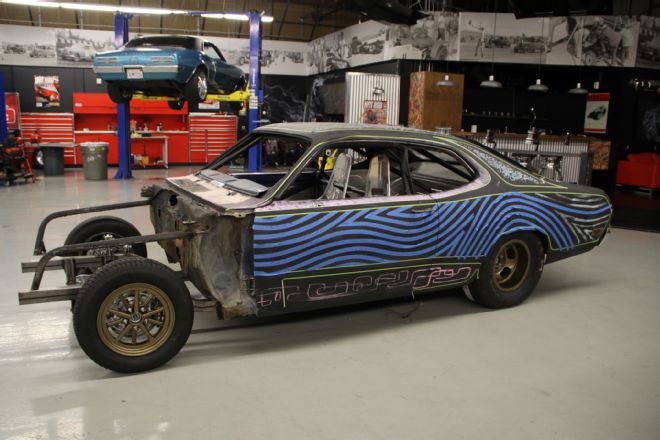
In addition to suspension, we've also been playing with paint ideas. The Harpoon laid on some sidewalk chalk and tape stripes to get us going. Check out Facebook.com/theflowercar for more.
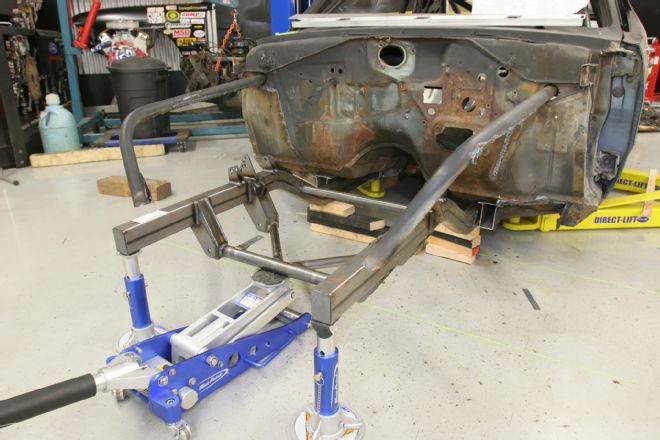
The key to the front frame clip is ride height as measured where the frame meets the firewall. In this photo, the stack of blocks equals a 6-inch ride height. The suspension fixtures were installed by the guys at Chassisworks before the frame was shipped.
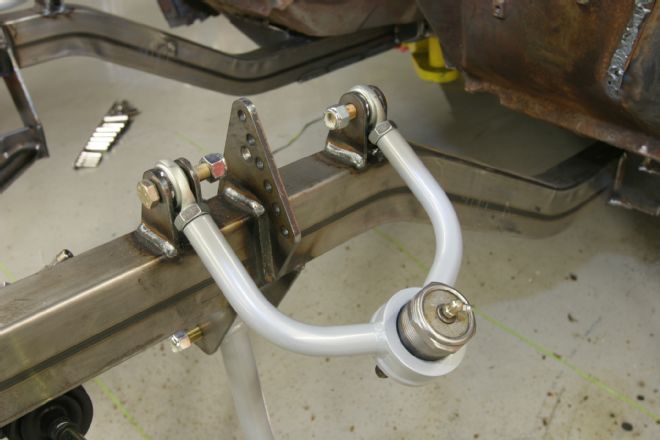
The upper control arm features Teflon rod ends for caster and camber adjustments and has screw-in ball joints so you don't have to wreck them with a pickle fork when you work on the suspension. The lack of a crossbar makes a lot of room for headers.
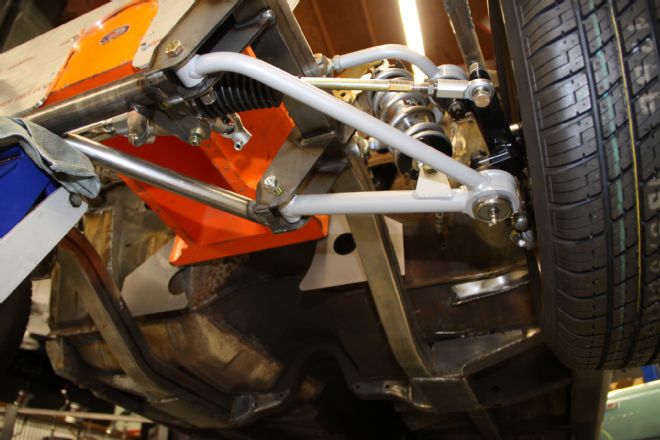
The lower control arms have replaceable polymer bushings for a more forgiving ride. They also have screw-in ball joints.
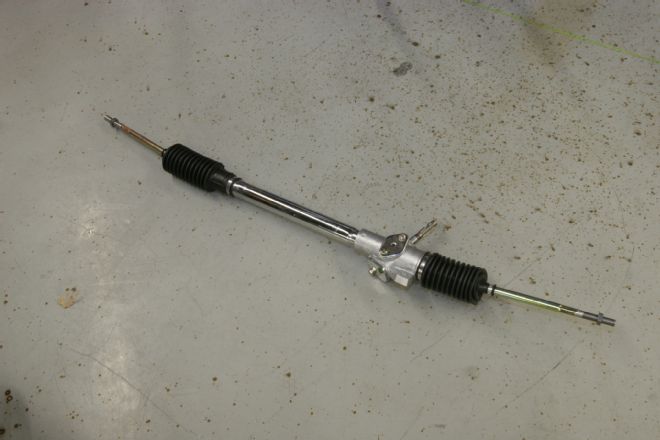
The heavy power steering unit was sold to another Mopar guy to make room for the ultra-light Pinto rack and pinion with 3.5-turns lock-to-lock and a total of 5-inches of travel. If we were going to drive this car more than a few miles, we'd pick the Mustang II or Pro-Box system.
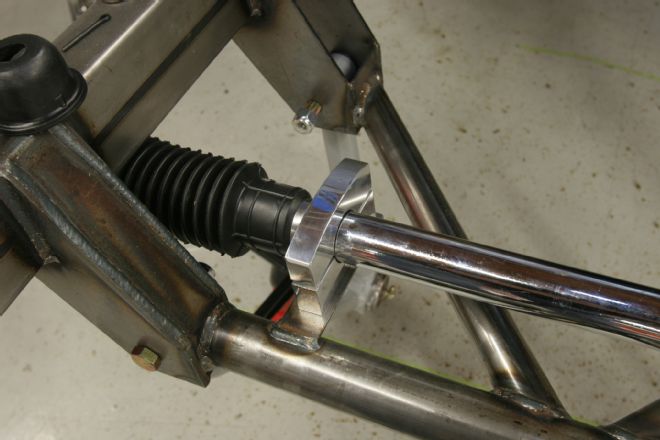
In extreme cases, the entire rack needs to be raised or lowered to eliminate bump steer. The frame clip has a mount for billet rack clamps that can be shimmed if needed.
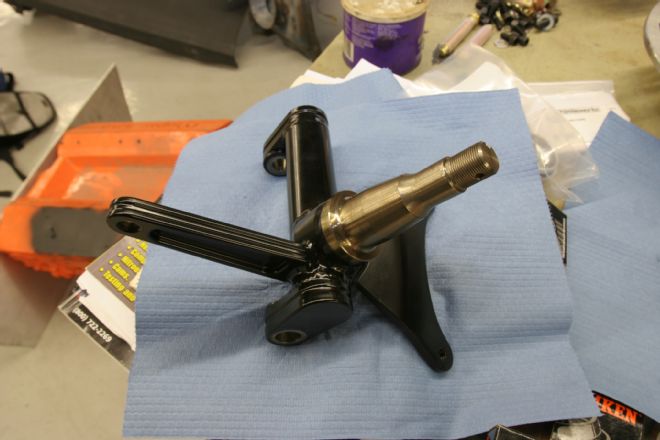
We chose the fabricated drag race spindles because they weigh only 6.5 pounds each. They also have an integrated bracket for the brakes.
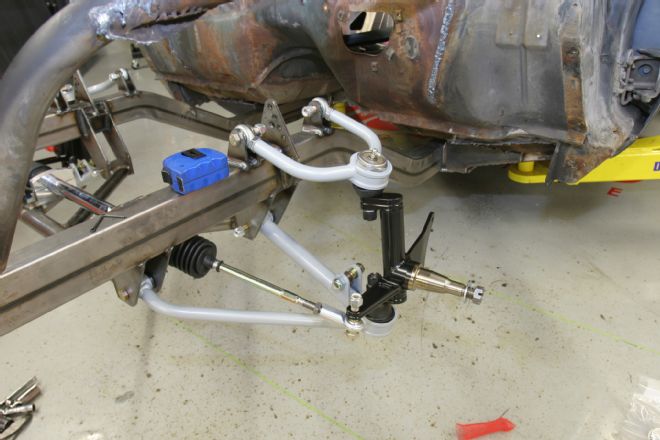
The tie rods use spherical rod ends instead of tapered ones. If you have tow-out at high speeds, the car will be uncontrollable.
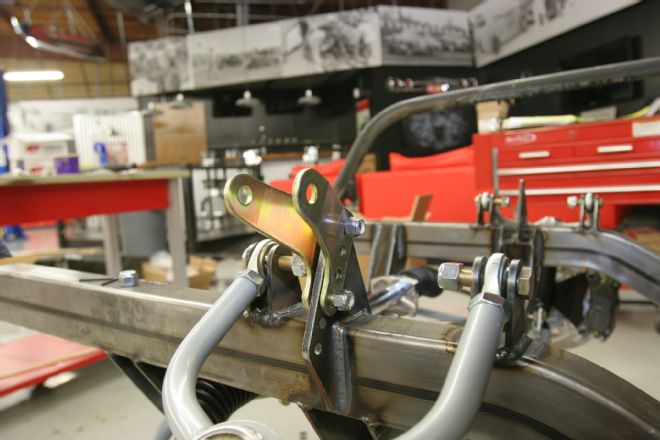
Again, the ride height should be measured at the frame way before you get to this point in the build. The adjustable shock mounts are designed to determine the eyelet-to-eyelet dimension at ride height.
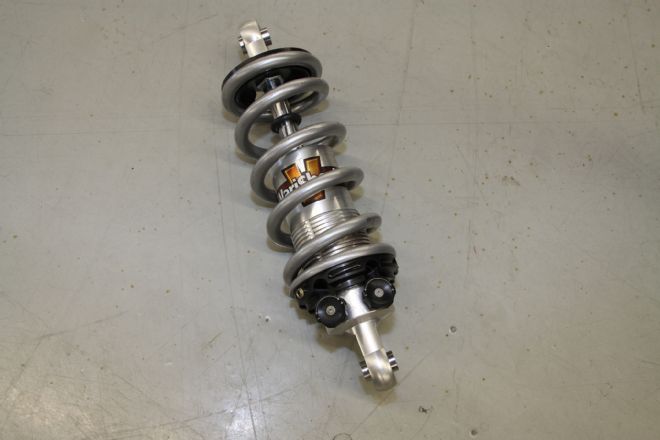
The shock's purpose in a dragcar is to keep the tire on the ground. A drag race travel baseline is 40-bump and 60-percent rebound. The selection of this coil-over is based on the performance application (lots of power-no weight) and the amount of compression at ride height. It only has 2.80-inches of total travel so following with what we discussed earlier in the text, this car will jump up out of the lights and take the wheel and tire with it.
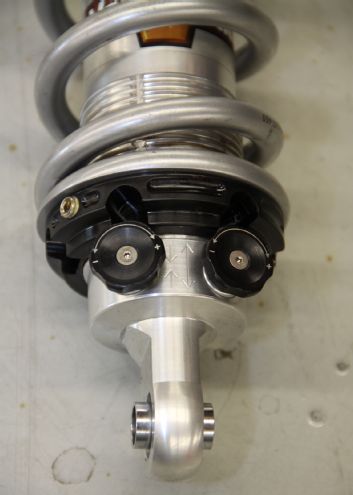
The double adjuster controls the rate of bump and rebound. This is an at-the-track tuning device to adjust the rate at which the shock controls the spring.
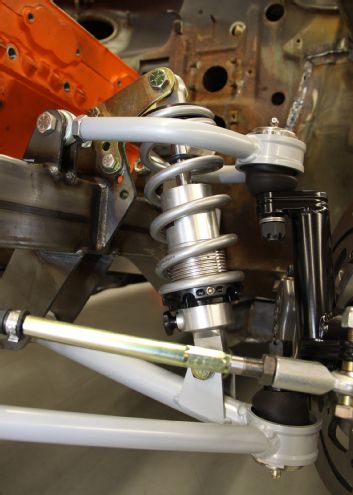
This black collar is designed to add preload to the coil-over, not control ride height. As you preload a spring its potential energy helps rotate the cars mass to the rear suspension and hopefully stand the car on the bumper or wheelie bars.
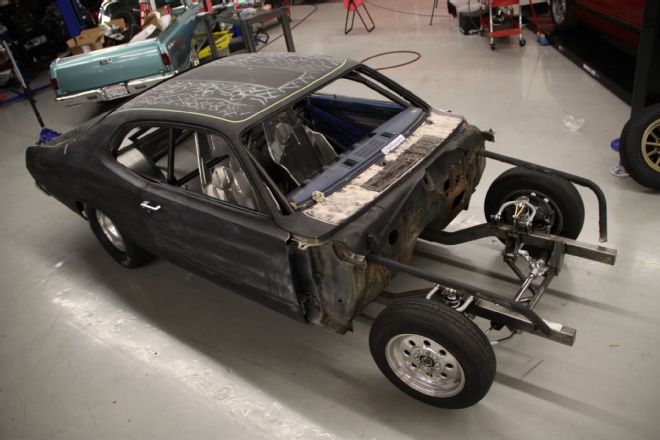
With everything installed and the lightweight wheels on the car, the Demon weighed 1,570 pounds.
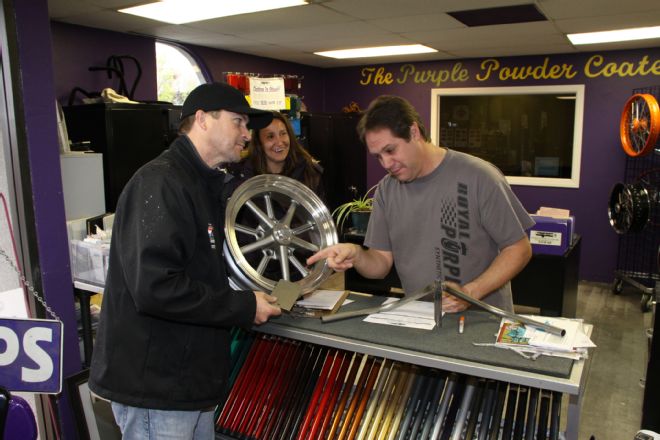
To get more of a vintage Funny Car look, we had the wheels powder coated at Andrew's in The Valley. The color is Ol' Brass and it looks just like the old Dow 7 coating from the ‘60s.
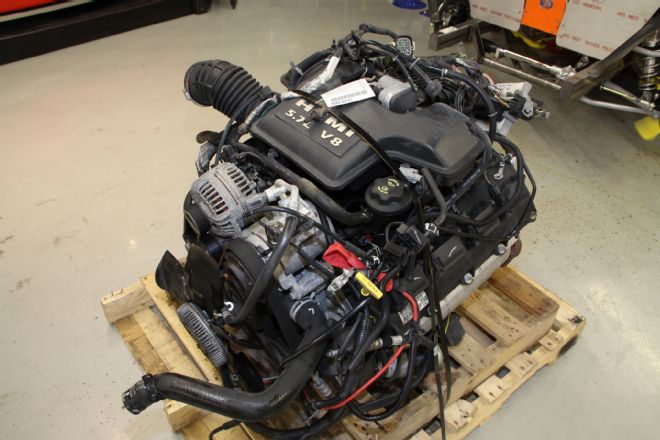
Coming next: We start playing with the eBay Hemi and the Performance Automatic 727.